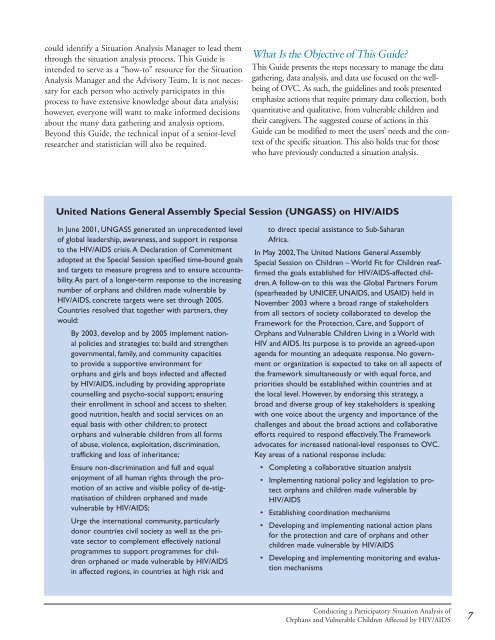Conducting a Participatory Situation Analysis of.pdf - Global HIV ...
Conducting a Participatory Situation Analysis of.pdf - Global HIV ...
Conducting a Participatory Situation Analysis of.pdf - Global HIV ...
You also want an ePaper? Increase the reach of your titles
YUMPU automatically turns print PDFs into web optimized ePapers that Google loves.
could identify a <strong>Situation</strong> <strong>Analysis</strong> Manager to lead them<br />
through the situation analysis process. This Guide is<br />
intended to serve as a “how-to” resource for the <strong>Situation</strong><br />
<strong>Analysis</strong> Manager and the Advisory Team. It is not necessary<br />
for each person who actively participates in this<br />
process to have extensive knowledge about data analysis;<br />
however, everyone will want to make informed decisions<br />
about the many data gathering and analysis options.<br />
Beyond this Guide, the technical input <strong>of</strong> a senior-level<br />
researcher and statistician will also be required.<br />
What Is the Objective <strong>of</strong> This Guide?<br />
This Guide presents the steps necessary to manage the data<br />
gathering, data analysis, and data use focused on the wellbeing<br />
<strong>of</strong> OVC. As such, the guidelines and tools presented<br />
emphasize actions that require primary data collection, both<br />
quantitative and qualitative, from vulnerable children and<br />
their caregivers. The suggested course <strong>of</strong> actions in this<br />
Guide can be modified to meet the users’ needs and the context<br />
<strong>of</strong> the specific situation. This also holds true for those<br />
who have previously conducted a situation analysis.<br />
United Nations General Assembly Special Session (UNGASS) on <strong>HIV</strong>/AIDS<br />
In June 2001, UNGASS generated an unprecedented level<br />
<strong>of</strong> global leadership, awareness, and support in response<br />
to the <strong>HIV</strong>/AIDS crisis.A Declaration <strong>of</strong> Commitment<br />
adopted at the Special Session specified time-bound goals<br />
and targets to measure progress and to ensure accountability.As<br />
part <strong>of</strong> a longer-term response to the increasing<br />
number <strong>of</strong> orphans and children made vulnerable by<br />
<strong>HIV</strong>/AIDS, concrete targets were set through 2005.<br />
Countries resolved that together with partners, they<br />
would:<br />
By 2003, develop and by 2005 implement national<br />
policies and strategies to: build and strengthen<br />
governmental, family, and community capacities<br />
to provide a supportive environment for<br />
orphans and girls and boys infected and affected<br />
by <strong>HIV</strong>/AIDS, including by providing appropriate<br />
counselling and psycho-social support; ensuring<br />
their enrollment in school and access to shelter,<br />
good nutrition, health and social services on an<br />
equal basis with other children; to protect<br />
orphans and vulnerable children from all forms<br />
<strong>of</strong> abuse, violence, exploitation, discrimination,<br />
trafficking and loss <strong>of</strong> inheritance;<br />
Ensure non-discrimination and full and equal<br />
enjoyment <strong>of</strong> all human rights through the promotion<br />
<strong>of</strong> an active and visible policy <strong>of</strong> de-stigmatisation<br />
<strong>of</strong> children orphaned and made<br />
vulnerable by <strong>HIV</strong>/AIDS;<br />
Urge the international community, particularly<br />
donor countries civil society as well as the private<br />
sector to complement effectively national<br />
programmes to support programmes for children<br />
orphaned or made vulnerable by <strong>HIV</strong>/AIDS<br />
in affected regions, in countries at high risk and<br />
to direct special assistance to Sub-Saharan<br />
Africa.<br />
In May 2002,The United Nations General Assembly<br />
Special Session on Children – World Fit for Children reaffirmed<br />
the goals established for <strong>HIV</strong>/AIDS-affected children.A<br />
follow-on to this was the <strong>Global</strong> Partners Forum<br />
(spearheaded by UNICEF, UNAIDS, and USAID) held in<br />
November 2003 where a broad range <strong>of</strong> stakeholders<br />
from all sectors <strong>of</strong> society collaborated to develop the<br />
Framework for the Protection, Care, and Support <strong>of</strong><br />
Orphans and Vulnerable Children Living in a World with<br />
<strong>HIV</strong> and AIDS. Its purpose is to provide an agreed-upon<br />
agenda for mounting an adequate response. No government<br />
or organization is expected to take on all aspects <strong>of</strong><br />
the framework simultaneously or with equal force, and<br />
priorities should be established within countries and at<br />
the local level. However, by endorsing this strategy, a<br />
broad and diverse group <strong>of</strong> key stakeholders is speaking<br />
with one voice about the urgency and importance <strong>of</strong> the<br />
challenges and about the broad actions and collaborative<br />
efforts required to respond effectively.The Framework<br />
advocates for increased national-level responses to OVC.<br />
Key areas <strong>of</strong> a national response include:<br />
• Completing a collaborative situation analysis<br />
• Implementing national policy and legislation to protect<br />
orphans and children made vulnerable by<br />
<strong>HIV</strong>/AIDS<br />
• Establishing coordination mechanisms<br />
• Developing and implementing national action plans<br />
for the protection and care <strong>of</strong> orphans and other<br />
children made vulnerable by <strong>HIV</strong>/AIDS<br />
• Developing and implementing monitoring and evaluation<br />
mechanisms<br />
<strong>Conducting</strong> a <strong>Participatory</strong> <strong>Situation</strong> <strong>Analysis</strong> <strong>of</strong><br />
Orphans and Vulnerable Children Affected by <strong>HIV</strong>/AIDS<br />
7















